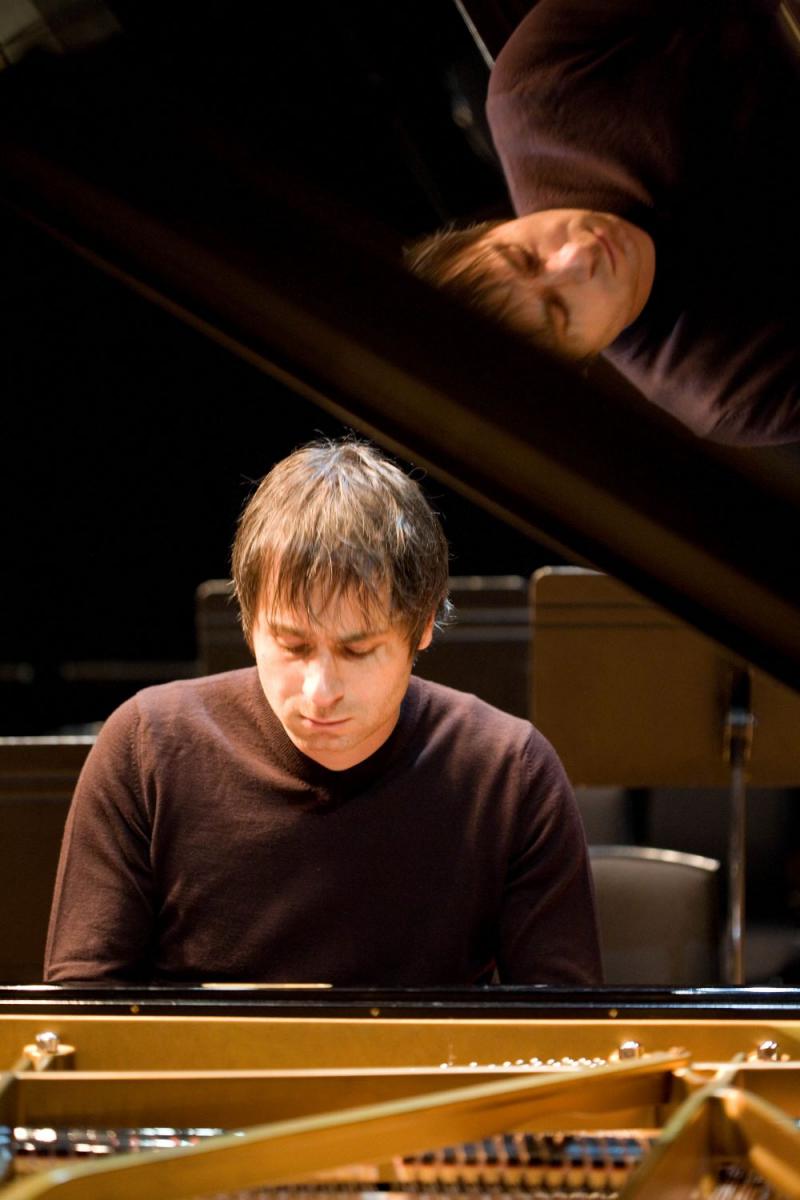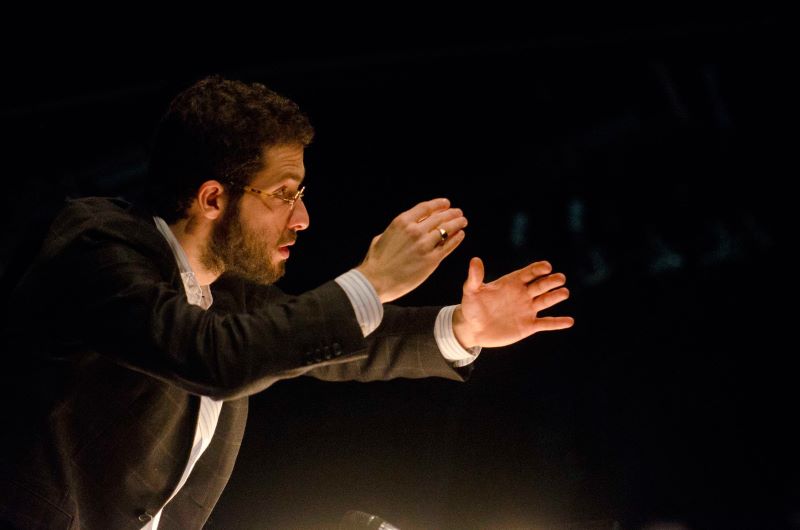Anderszewski, CBSO, Wellber, Symphony Hall Birmingham review - grandeur in restraint | reviews, news & interviews
Anderszewski, CBSO, Wellber, Symphony Hall Birmingham review - grandeur in restraint
Anderszewski, CBSO, Wellber, Symphony Hall Birmingham review - grandeur in restraint
Mozartian Bartók and Bruckner with itchy feet, as Omer Meir Wellber saves the day

No orchestra wants its conductor to cancel in the week of a concert.
And of course – always worth the price of admission – we still had Piotr Anderszewski as soloist in Bartok’s Third Piano Concerto. Wellber’s opening orchestral shimmer had an electrical charge to it: a sound that had an unquestionable presence in the hall and a sign that this performance was to be a dialogue as much as a matter of colour and atmosphere. Anderszewski declaimed his opening melody as if improvising; the movement that followed was a thing of clear edges, bold primary colours and a Mozartian sense of proportion, vividly articulated by a particularly plangent-sounding woodwind section and Anderszewski’s way of admitting just the tiniest suggestion of a lift at the end of a phrase.
In the Adagio religioso, too, Wellber gently teased out the texture of the opening string chorale – so often played at a breathless, homogenous whisper, but here very much alive and moving, with the cellos and basses softly tugging the music forward. The stillness that surrounded Anderszewski’s responses was all the more profound because of it: he placed lucid, luminous chords directly into the silence as if he was setting jewels into snow. And he never appeared to break a sweat in the finale, powering through thunderous double-octaves in perfect step with Wellber’s buoyant, whirling dance rhythms. Should it really look this easy? I just know that the final, headlong bars – the ones that the dying Bartók only sketched, leaving the orchestration to Tibor Serly – sounded as purposeful as they were exultant.
Wellber (pictured above, by Tato Baeza) carried that same control and sense of purpose, into Bruckner’s Sixth Symphony. No suggestion of a regimented march rhythm here: the violins’ opening pulse was like a firing synapse, as the main theme accelerated from a standing start to a genuinely thrilling momentum. That opening burst of energy charged the whole performance; the strings almost seeming to swing their second subject forward over pizzicato basses, and the thunderclap of Matthew Hardy’s timpani signalling successively more massive brass build-ups. With the timpani behind the first violins, facing off against the basses, and the brass forming an unbroken wall across the back of the orchestra, Bruckner’s monumental climaxes were as black toned and weighty as any Wagnerite could have wished.
And yet there was plenty of enchantment here: the rich, singing intensity of the strings at the start of the Adagio, Marie-Christine Zupancic’s sunlit flute soaring like the Woodbird over the outer movements’ more Siegfried-like rustlings, and Wellber’s sometimes poignant, sometimes frustrating way of letting a violin phrase blossom only to sweep the rest of the orchestra onwards and out from under their feet. With nervous energy in every bar, as well as an absolute refusal to indulge in bombast, the final ascent – resplendent as it was, with the CBSO’s horns punching for the heavens – felt like something more provisional than a grand entry into Valhalla. But the audience cheered anyway: perhaps in recognition that while more romantic visions of Bruckner are certainly available, Wellber had given us something of intelligence, integrity and real - if sometimes troubling – beauty.
rating
Share this article
Add comment
The future of Arts Journalism
You can stop theartsdesk.com closing!
We urgently need financing to survive. Our fundraising drive has thus far raised £49,000 but we need to reach £100,000 or we will be forced to close. Please contribute here: https://gofund.me/c3f6033d
And if you can forward this information to anyone who might assist, we’d be grateful.

Subscribe to theartsdesk.com
Thank you for continuing to read our work on theartsdesk.com. For unlimited access to every article in its entirety, including our archive of more than 15,000 pieces, we're asking for £5 per month or £40 per year. We feel it's a very good deal, and hope you do too.
To take a subscription now simply click here.
And if you're looking for that extra gift for a friend or family member, why not treat them to a theartsdesk.com gift subscription?
more Classical music
 Hallé John Adams festival, Bridgewater Hall / RNCM, Manchester review - standing ovations for today's music
From 1980 to 2025 with the West Coast’s pied piper and his eager following
Hallé John Adams festival, Bridgewater Hall / RNCM, Manchester review - standing ovations for today's music
From 1980 to 2025 with the West Coast’s pied piper and his eager following
 Kaploukhii, Greenwich Chamber Orchestra, Cutts, St James's Piccadilly review - promising young pianist
A robust and assertive Beethoven concerto suggests a player to follow
Kaploukhii, Greenwich Chamber Orchestra, Cutts, St James's Piccadilly review - promising young pianist
A robust and assertive Beethoven concerto suggests a player to follow
 Robin Holloway: Music's Odyssey review - lessons in composition
Broad and idiosyncratic survey of classical music is insightful but slightly indigestible
Robin Holloway: Music's Odyssey review - lessons in composition
Broad and idiosyncratic survey of classical music is insightful but slightly indigestible
 Classical CDs: Wolf-pelts, clowns and social realism
British ballet scores, 19th century cello works and contemporary piano etudes
Classical CDs: Wolf-pelts, clowns and social realism
British ballet scores, 19th century cello works and contemporary piano etudes
 Bizet in 150th anniversary year: rich and rare French offerings from Palazzetto Bru Zane
Specialists in French romantic music unveil a treasure trove both live and on disc
Bizet in 150th anniversary year: rich and rare French offerings from Palazzetto Bru Zane
Specialists in French romantic music unveil a treasure trove both live and on disc
 Scottish Chamber Orchestra, Ibragimova, Queen’s Hall, Edinburgh review - rarities, novelties and drumrolls
A pity the SCO didn't pick a better showcase for a shining guest artist
Scottish Chamber Orchestra, Ibragimova, Queen’s Hall, Edinburgh review - rarities, novelties and drumrolls
A pity the SCO didn't pick a better showcase for a shining guest artist
 Kilsby, Parkes, Sinfonia of London, Wilson, Barbican review - string things zing and sing in expert hands
British masterpieces for strings plus other-worldly tenor and horn - and a muscular rarity
Kilsby, Parkes, Sinfonia of London, Wilson, Barbican review - string things zing and sing in expert hands
British masterpieces for strings plus other-worldly tenor and horn - and a muscular rarity
 From Historical to Hip-Hop, Classically Black Music Festival, Kings Place review - a cluster of impressive stars for the future
From quasi-Mozartian elegance to the gritty humour of a kitchen inspection
From Historical to Hip-Hop, Classically Black Music Festival, Kings Place review - a cluster of impressive stars for the future
From quasi-Mozartian elegance to the gritty humour of a kitchen inspection
 Shibe, LSO, Adès, Barbican review - gaudy and glorious new music alongside serene Sibelius
Adès’s passion makes persuasive case for the music he loves, both new and old
Shibe, LSO, Adès, Barbican review - gaudy and glorious new music alongside serene Sibelius
Adès’s passion makes persuasive case for the music he loves, both new and old
 Anja Mittermüller, Richard Fu, Wigmore Hall review - a glorious hall debut
The Austrian mezzo shines - at the age of 22
Anja Mittermüller, Richard Fu, Wigmore Hall review - a glorious hall debut
The Austrian mezzo shines - at the age of 22
 First Person: clarinettist Oliver Pashley on the new horizons of The Hermes Experiment's latest album
Compositions by members of this unusual quartet feature for the first time
First Person: clarinettist Oliver Pashley on the new horizons of The Hermes Experiment's latest album
Compositions by members of this unusual quartet feature for the first time

Comments
I probably wasn't the only
Does anybody know what Piotr
I'm afraid I've no idea: